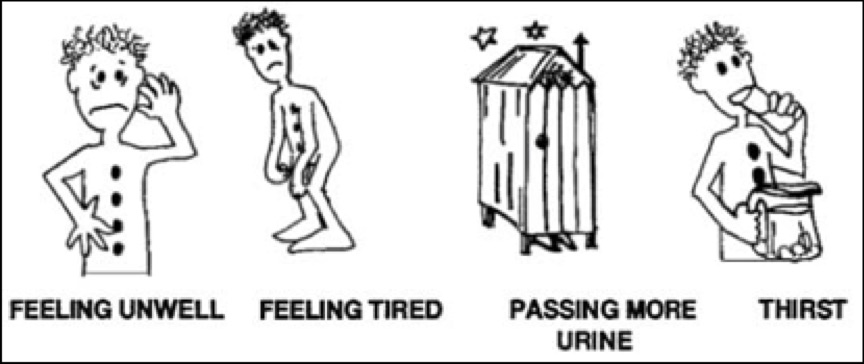What is Diabetes?
Diabetes is an old illness. It has affected mankind for many hundreds of years and is referred in old Sanskrit writing. It is a chronic metabolic disorder with high levels of sugar in the blood. The word “Diabetes” means siphon and “Mellitus” stands for sweet.
The words Diabetes and Diabetes Mellitus are used interchangeably in day-to-day practice.

How does it happen?
A gland in the tummy named pancreas secretes a hormone called Insulin, which controls blood sugar. When we eat, glucose is absorbed from the stomach and enters in the blood. The glucose must enter into the cells to make energy and insulin helps glucose to enter the cells.
Diabetes is the result of the inability of the pancreas to produce a normal amount of Insulin or Insulin becoming ineffective to do its’ job.
Diabetes: Why me?
Remember it is not your fault that you have Diabetes. You are just happened to be the person who got it. In India 7-8% of villagers and up to 15% of city dwellers has Diabetes. Recent studies showed all over the world the incidence of Diabetes is increasing and it is more so in Asians.
Who are at risk of Diabetes?
Family history of Diabetes is the major risk factor. Sedentary life-style, obesity, smoking, excessive alcohol intake, high blood pressure and in case of women previous Diabetes in pregnancy or delivering big baby (birth weight more than 4Kg) are risk factors for Diabetes.
What are the symptoms of Diabetes?
In adults, at least at the beginning, you may not have any symptom. When your blood sugar is above 180 mg%, sugar starts appearing in the urine.
Sugar in the urine drags water and you pass a lot of urine and feel dry and thirsty. You may also feel tired and loose weight. Your appetite increases and peculiarly you may notice that you are loosing weight in spite of eating more.
Chance of infection is higher if you have high sugar and also your healing from infection, cut or wound may be unusually delayed. Some people complain of poor eyesight.

How do we diagnose Diabetes?
The normal blood glucose in the morning before taking any food (fasting) is less than 100 mg%. There are three ways we diagnose Diabetes. Urine glucose is not reliable for diagnosis.
- Fasting blood glucose 126 or more is diagnostic of Diabetes; value in-between 100 to 125 is called borderline Diabetes.
- A random blood glucose sample taken anytime of the day more than 200mg% is also diagnostic of Diabetes. If there are no symptoms a repeat test is needed.
- In doubtful cases sample is taken after a glucose drink, called glucose tolerance test.
- HbA1C, an average of last 3 months control, can also diagnose Diabetes – Normal <5.7, pre-Diabetes 5.7 – 6.4 and Diabetes 6.5 or more.
What are the types of Diabetes?
There are two main types:
- type 1 or young onset
- type 2 or adult onset Diabetes.
In type 1 Diabetes pancreas does not produce Insulin and you cannot survive without Insulin.
In type 2 diabetes, the pancreas does produce insulin but it is insufficient and/or less effective.
Diabetes can manifest for the first time in pregnancy, called Gestational Diabetes. Now we have tests to differentiate type 1 from type 2 Diabetes.
Is there any good news about Diabetes?
The good news is that with proper care you can avoid or at least postpone the deadly complications of Diabetes. The bad news is that Diabetes is not going to go away.
At present the word “cure” is not there for Diabetes. So, Control your Diabetes, do not allow Diabetes to control you.
Can we prevent Diabetes?
If you have a genetic risk for developing diabetes because of family history, you cannot do anything about that.
Things you can do are healthy eating (i.e., eating vegetables and fruits, avoiding fast food), healthy lifestyle (regular exercise, avoidance of smoking, moderation of alcohol, etc) and keeping your weight in accordance to your height.
Certain medicines are being used recently for preventing Diabetes in people who have borderline Diabetes.